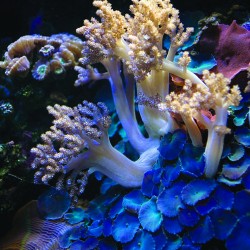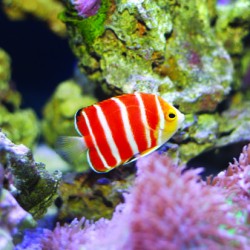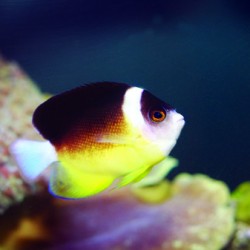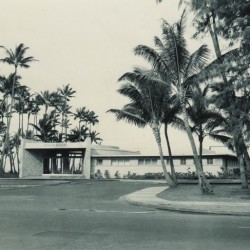Off the Beaten Path: Life Aquatic
It may be tempting for some to think of Waikiki Aquarium as a tourist attraction where pint-sized travelers, who need a break from the beach or a rainy-day activity, can meet the real-life versions of Dory and Nemo.
However, as the third-oldest aquarium in the nation moves toward its 110th birthday on March 19, it’s among the most historic and scientifically rich marine science resources in the world. Some 330,000 tourists and scientists come each year from around the globe to see the aquarium, which has been owned by the University of Hawai’i since 1919 and is home to species not seen in any other such public setting. You might say that the aquarium has come a long way from its beginning in 1904, when James B. Castle and Charles M. Cooke, the directors of a transit company, founded it as a way to bring people to the end of their streetcar line.
“It used to be the end of the line, but now it’s the start of a journey of exploration with the sea,” says Waikiki Aquarium Director Dr. Andrew Rossiter, whose career has taken him to five continents, and includes studies on the ecology, evolution and behavior of animals as diverse as cichlid fish, fresh water insects, sturgeons, coral reef fish, birds and tortoises.
While the aquarium houses 500 marine species and maintains more than 3,500 marine specimens, top on the viewing list by those in the know is a peppermint angelfish. The unique fish, which was collected in water depths of 400 feet off Mo’orea, Tahiti, by Bishop Museum’s Dr. Richard Pyle, is a sight that few scientists would have encountered outside of Waikiki Aquarium. The beautiful candy-striped fish can only be seen in its natural setting by deep divers, who are trained to use rebreathers. It was originally slated to become a Smithsonian Institution specimen.
“The Smithsonian was persuaded to give it to us on loan provided that we return it to them once it dies,” Rossiter says. “To illustrate how rare this fish is, it went on display on a Sunday, and by Monday, a collector from Japan had called to offer roughly $30,000 to buy it.”
- Abe’s Angelfish
- Photos: Courtesy Waikiki Aquarium
- As the third-oldest aquarium in the nation moves toward its 110th birthday on March 19, it’s among the most historic and scientifically rich marine science resources in the world.
Another fish that can only be seen at the Waikiki Aquarium is an Abe’s angelfish, which is native to Indonesia and Palau. This fish was only just discovered in 2001 during a submersible dive and was taken to Pyle, who identified it as a new species.
“We’ve had him for seven years and he’s valued at $15,000 more for his rarity than his beauty,” Rossiter says.
The Waikiki Aquarium also is the first in the world to keep live coral, breed it and perfect its shipping techniques.
It serves as a genetic and specimen repository for the purple and brown colored irregular rice coral, Montipora dilatata, which exists in only two localities in the wild and is listed as a “Species of Concern” by the National Marine Fisheries Service.
The aquarium’s Northwestern Hawaiian Islands exhibit, which opened about two years ago, displays marine species taken from the conservation area at the Papahanaumokuakea Marine National Monument, where a quarter of the marine species live that are found nowhere else on earth. This exhibit contains the unique Hawaiian mor-wong, which is not found in any other aquarium in the world.
“The marine life that comes from this exhibit are so isolated that you can’t get to them in their natural setting,” Rossiter says. “The only access to the protected areas of the Northwestern Hawaiian Islands is by research vessels. Our exhibit brings you as near to them as you’d ever get without getting wet.”
Look for more exciting things to come in the next decade of this historic and scientific treasure. A new seahorse, seadragon and pipefish gallery will open in June replacing the wall of reef machines, mollusk and the Hawaiian display along the sea displays.
The aquarium also has built a breeding facility for these creatures, and in March, also will open a live foods production area to grow the artemia (tiny shrimps) that feed seahorses and other fish. The aquarium also grows different sized phytoplankton and zooplankton because Rossiter says, “Some of the fish are really particular about the microscopic differences in the versions that they eat.”
“We like to focus on self-sustaining populations,” he says. “That’s something that every aquarium should be doing. We can’t justify going out in the water and taking fish, and when they die, replacing them with more.”
An ocean scientist, hired by the aquarium this spring, will develop an ocean science laboratory allowing museum visitors (even the scientifically challenged like myself) to participate in research. Among the projects that have been proposed are tracking tiger sharks in real time, examining the implications of rising ocean levels in Waikiki and the impact of currents on surfers.
For all of these reasons and more, it’s worth a journey through Waikiki Aquarium. It’s one of the best reminders that despite modernization, parts of Hawai’i remain the rare and special place that you would expect of the world’s most geographically distant land mass and surrounding waters.
Did you know?
The table corals, masked angelfish, yellow barbel goat-fish and Japanese pygmy angelfish that can be viewed at a 4,000-gallon display in Waikiki Aquarium are abundant around the Northwestern Hawaiian Islands, but are extremely rare or absent around the main Hawaiian Islands.
A three-time national award winning reporter, Allison Schaefers serves as the Waikiki Bureau Chief for the Honolulu Star-Advertiser. Based in Waikiki, she covers Hawai’i tourism and Waikiki issues. Contact her at aschaefers@staradvertiser.com.














